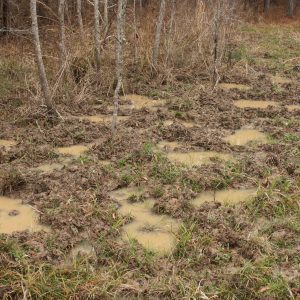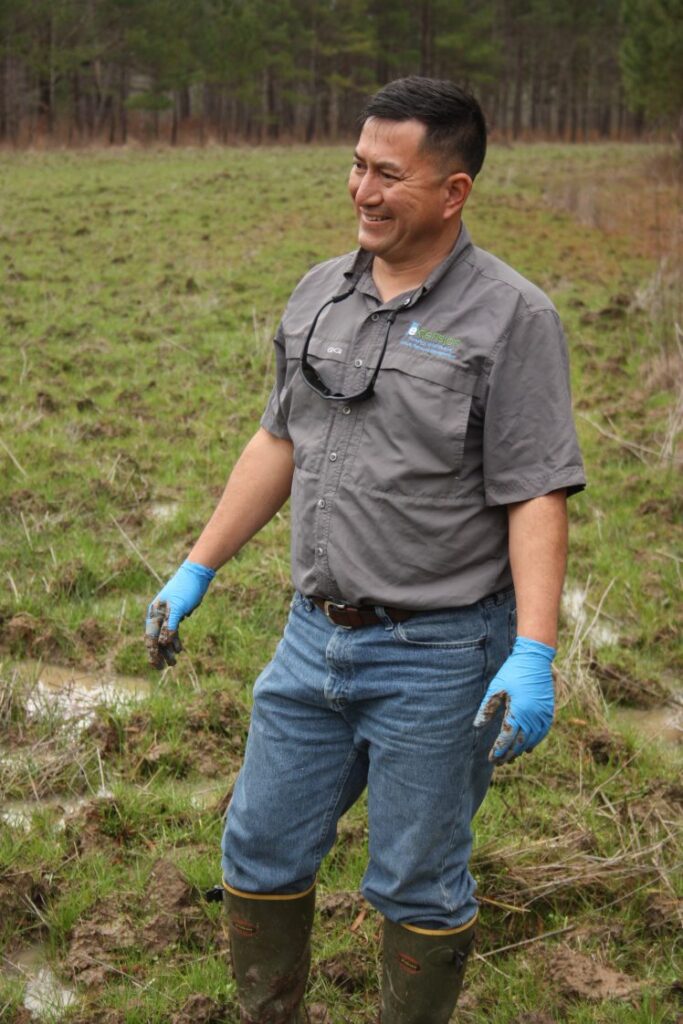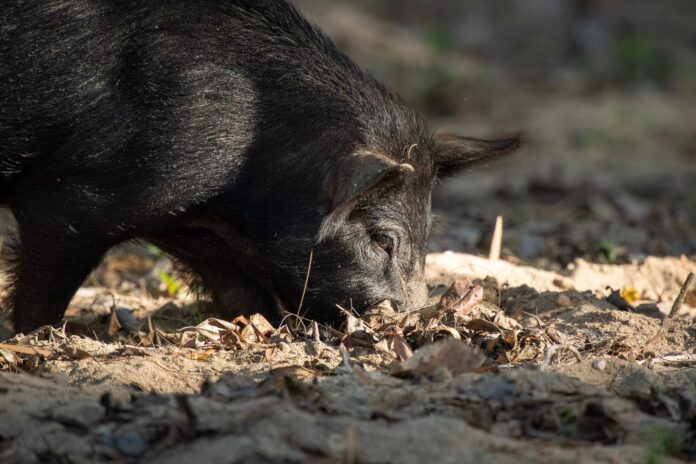AUBURN UNIVERSITY, Ala. – Wild pigs are arguably one of the most detrimental wildlife species. These animals have the potential to decimate crops, wildlife habitat and food plots. Virtually every natural resource can be affected by these creatures. The Alabama Cooperative Extension System encourages all landowners and wildlife enthusiasts to learn more about these destructive animals. You may not be able to take the wild out of the hog, but you can take the hog out of the wild.
Mark Smith, an Alabama Extension expert of forestry and wildlife sciences, has dedicated his career to wildlife sciences. Smith began his service with Extension and Auburn University in 2007, where he has specialized in wildlife damage management, especially wild pigs. According to Smith, eradicating a non-native species such as wild pigs can be a difficult process.
“Wild pigs compete for food and cover resources with some of the state’s economically important game species such as white-tailed deer and wild turkeys,” Smith said. “They can also have a significant impact on water quality in local watersheds.”
In Alabama, the greatest populations of wild pigs are in the southern half of the state. From central to north Alabama, pigs live in smaller pockets ranging to the Tennessee border. To see where the greatest pig concentrations are in your state, view the USDA Animal and Plant Health Inspection Service maps at www.aphis.usda.gov.
The wild pig effect

Wild pig damage to forestland
According to Smith, who is also a professor in the Auburn University College of Forestry, Wildlife and Environment, managing wild pig populations is critical in maintaining water quality.
“In one study conducted in Alabama from 2018 to 2020, researchers found that E. coli and fecal coliform concentrations were about three to four times greater in streams with wild pigs present,” Smith said. “This far exceeds Environmental Protection Agency (EPA) concentration standards for recreational watersheds.”
To prevent private or local water resources from contamination by pig bacteria, a concerted effort to control pig populations is the best defense. Smith said the study concluded that – with reduction of pig population over time – concentrations of bacteria can reduce by up to 75%.
The presence of feral pigs also influences other wildlife populations. Because they are territorial as well as destructive, wild pigs often push other species out of their habitats. Smith said further research studies show this applies to wild turkeys and their reproduction success.
“When wild pigs are removed, turkeys were more abundant,” Smith said. “Immediate responses (one year after pig removals) were likely due to turkeys moving in from adjacent properties. However, researchers observed a significant increase in turkey poults between two to three years after wild pig removals, which was indicative of increases in either nest success or poult survival.”
Oh deer
For deer hunters, there is no relief from the wild pig effect either. Having accurate information about a deer herd is critical for wildlife management and a successful hunt. Smith said wild pigs can also throw a wrench in those efforts.
“If you’re conducting camera surveys of white-tailed deer on your property to estimate deer abundance or maybe get an idea of the number of bucks roaming the property – you guessed it – wild pigs may have a significant impact on what you see and what you don’t see,” Smith said.
Corn is often a popular bait for game camera placements to attract wildlife. According to further research at Auburn University, feral pigs can also prohibit hunters from having accurate results when using baiting techniques to lure animals in front of cameras. In many instances, pigs were clearly captured competing with immature white-tailed bucks for food resources, causing them to disperse.
“If you’re conducting camera surveys and have pigs, know that your results will be a bit off,” Smith said.
Resources

Alabama Extension Wildlife Sciences Professor Mark Smith conducts wild pig research.
Natural resources like food, water and shelter are imperative for a healthy wildlife population. Pigs, deer, turkey and many other species forage on the same food resources. Acorns are one of the most popular items on the menu, and Smith said there are no reservations for dinner in the wild.
“Acorns are an important food source in the fall and winter for many species, especially economically important game species like white-tailed deer and turkeys,” Smith said. “Another recent study found that wild pigs are a voracious competitor and may consume up to 23% of the acorn crop each year. However, when wild pig populations were significantly reduced the following year, acorn consumption dropped to only 7.2%.”
If it seems like a hog problem cannot get any worse, don’t forget about row crops. Agriculture producers and those who utilize row crops for food plots are no strangers to pig devastation. Wild pigs have rooting and wallowing behaviors, which damage soil and crops. Also, they can prey on livestock, especially newborn calves, lambs and goats. Smith said wild pig damage to agriculture likely exceeds $1 billion nationally each year.
Control
At the first sign of wild pigs, landowners should use control measures to get a handle on the situation. Wild pigs can reproduce quickly, providing little time before they can decimate resources. Smith suggests that adjoining landowners and managers work together to eradicate swine populations.
“It’s much easier to control wild pigs when they first invade and only a few individuals are present,” he said. “Significantly reducing or eradicating them takes a lot of work if done properly.”
There is a preferred method to removing pigs from small acreages at a time. By using premeditated, systematic and intensive practices, wildlife managers can successfully meet their goals.
“In most cases, hunting or opportunistic shooting of wild pigs will rarely control a population,” Smith said. “Live trapping using large, corral style traps and humanely euthanizing the pigs is the most cost- and time-effective means of removal.”
Pig out
Utilizing unbiased scientific information from wildlife professionals is the best start to addressing a wild pig problem. To get pigs out, education and proven practices must come into play. This is where Alabama Extension can help.
Alabama Extension takes the expertise of Auburn University and Alabama A&M University to the people. Our educators in all 67 counties are environmental partners — bringing practical ways to better our homes, farms, people and the world around us. Our research extends knowledge and improves lives.
Want to learn more about wild pig management? Visit www.aces.edu or contact your local Extension office.





















